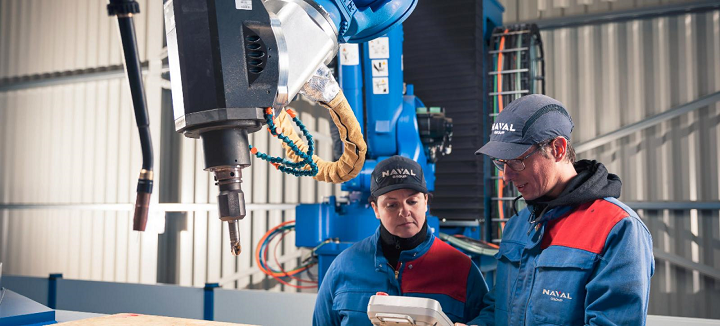While we often discuss the many rules and regulations involved with 3D printing for the aviation industry, make no mistake: things are just as exacting when it comes to 3D printing for maritime applications, as well. French Naval Group, which specializes in naval defense and marine renewable energy, was the first to 3D print a full-scale propeller blade demonstrator for military use, and has now announced the creation of a next-generation 3D printed propeller that will power the French Navy’s Tripartite minehunter FS Andromède (M643) ship. Naval Group, which designed the metal propeller, manufactured it using wire arc additive manufacturing (WAAM) technology, which has been utilized in the past to print other propellers.
“The assembly of this 3D-printed propeller shows great promise for the future,” stated Eric Balufin, Director of the Naval Group site of Brest. “This new technology will enable us to considerably reduce technical constraints, and therefore allow for new manufacturing solutions for complex geometrical shapes which cannot be produced through conventional processes. It will also enable us to greatly reduce production time and consequently in-service support.”
Spanning 2.5 meters, the propeller weighs a whopping 1 metric ton, featuring five 220 kg 3D printed blades. WAAM, which is a better AM technique for large-scale applications, uses a robotic arm to melt metal wire that’s been heated up by an electric arc. The robots and other manufacturing tools for the work were supplied by the French subsidiary of the Yaskawa Group in Japan.
[#FABRICATIONADDITIVE] ⚓️ Naval Group équipe l’Andromède, un chasseur de mines tripartite de la @MarineNationale d’une hélice nouvelle génération réalisée grâce à la fabrication additive métallique. ⚙️ L’hélice va accompagner le navire dans toutes ses missions opérationnelles. pic.twitter.com/L4rkBmhhqj
— Naval Group (@navalgroup) January 13, 2021
As previously mentioned, there are pretty intense standards and requirements to be met with maritime 3D printing, such as corrosion, fatigue, and shock resistance, due to the difficult conditions ships constantly find themselves in. The Naval Group worked with Bureau Véritas to ensure that all of the certification, testing, and inspection requirements were met, so that the Fleet Support Services (FSS) and the French Defence Procurement Agency (DGA) would authorize a trial of the 3D printed blades on an actual Navy ship.
“Obtaining military naval quality requires rigorous development. Nearly three years of R&D – carried out by the Technical and Innovation Department in cooperation with the Ecole Centrale de Nantes within the framework of the LabCom Joint Laboratory of Maritime Technology – went into the development of the deposition process of metal wire fusion. Today, we witness a world first,” Emmanuel Chol, Director of the Naval Group’s Nantes-Indret site, said. “It is the largest metal 3D-printed thruster ever to have been manufactured and the first propeller resulting from this technology, embarked on board a military ship and manufactured for use beyond just sea trials.”
The 3D printed blades were successfully certified, and the propeller was transferred from the manufacturing site of Nantes-Indret to Brest this fall. The assembly was then sent to the submarine base, where it was mounted onto the intermediate propeller shaft of the French Navy ship Andromède in November. The ship is one of ten Tripartite mine hunters built in the 1980s for the French Navy, and eight of these, including the Andromède, won’t be retired for another ten years. So it’s imperative that the propeller and its 3D printed blades work properly.

(Image courtesy of DefPost)
Successful sea trials of the tripartite minehunter ship with its new propeller occurred in December, so the Andromède can now get back to work, along with its 3D printed propeller.
But Naval Group isn’t stopping there: it’s begun a new development phase with the purpose of revamping the design of other ships through the use of 3D printing, such as thrusters. The technology can offer increased part productivity, reduced weight, acoustic discretion, better thrust efficiency, and so much more.

France’s Naval Group announced it had 3D printed the world’s first propeller for use on an operational mine hunter of the French navy.
(Sources: DefenseNews, Naval Group / Images courtesy of Naval Group unless otherwise noted)
Subscribe to Our Email Newsletter
Stay up-to-date on all the latest news from the 3D printing industry and receive information and offers from third party vendors.
You May Also Like
NSF Awards Kentucky $1M for Advanced Manufacturing
The National Science Foundation has awarded a $1 million grant to the University of Louisville for the Advancing Manufacturing and Building Construction Technologies (NSF AMT) project. This initiative is part...
3D Printing News Briefs, May 11, 2024: 3D Printed Stent, Tower, Sculptures, & More
We’re starting off with medical research in today’s 3D Printing News Briefs, as researchers in Korea used CT images and 3D printing to fabricate an educational simulator for a mastoidectomy....
3D Printing Unpeeled: Wind Turbines, Probiotics and Lenses
TPI Composites, ORNL and Ingersoll Rand are working to make wind turbine tooling segments that can be 18.3 meters long. These elements also include resistive wires that help keep the...
Tethon 3D Releases Cost-effective Bioprinter
Tethon 3D, known for its ceramic-loaded DLP materials, custom resins, and DLP 3D printers, has recently released a bioprinter. Vat polymerization printers like DLP systems have been widely used by...

































